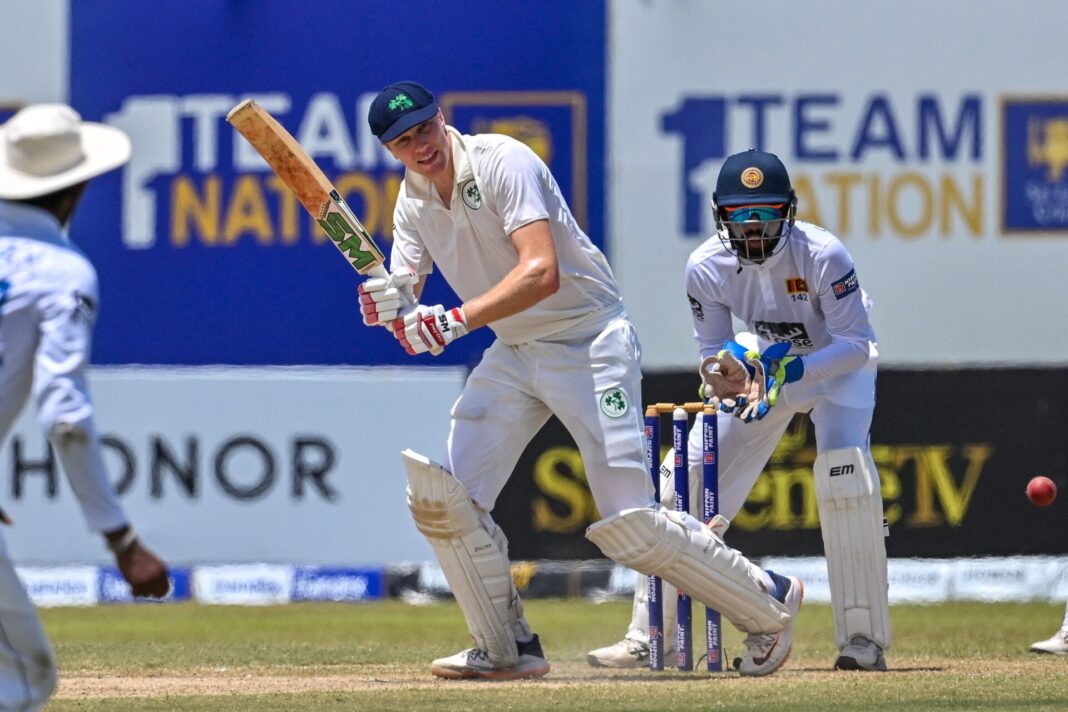
Hopes were high after a spirited finish to Ireland’s only Test against Bangladesh a few weeks ago.
Lorcan Tucker’s incredible test century on debut, and all round display from Andy McBrine (six first innings wickets plus 72 in Ireland’s second innings) left hopes of an historic first Test win.
The visitors eventually lost by seven wickets. But an incredible third day in Mirpur will live long on in the memories of Irish cricket fans.
Things proved much trickier in Sri Lanka with the tourists falling to an innings defeat by an innings and 280 runs. But a very impressive fightback was mounted on days one and two in the second outing.
There were hundreds from Paul Stirling (who was added to the squad after his time off in Vietnam) Curtis Campher, aided with runs from that man again Lorcan Tucker, and captain Andrew Balbirnie who fell agonisingly short of what would have been his first Test century.
492 was certainly impressive for a first innings total, as well as providing Ireland with their highest ever total in their six Test matches to date. However this challenge was quickly put to bed as Sri Lanka mounted a mammoth 704 for 3 declared in brutal heat on an unforgiving pitch.
Ireland eventually lost by an innings and ten runs, succumbing to 202 all out in their second innings largely led by a Harry Tector 85.
This displayed the harsh brutality of Test cricket. To lose by an innings having posted almost 500. And for that result to become a record in itself – England being the previous holders of the record of the team to post the highest first innings total and then lose by an innings against India in 2016.
Ireland in a way will be better though for this. It highlights the gaps on the biggest stage in cricket’s most testing format. Although the tourists fielded admirably, key dropped catches of course came back to bite them. An inability to control the Sri Lankan batters left the Irish nowhere to hide in difficult heat.
A notable attack mounted on the debutant left arm spinner Matt Humphreys by Kusal Mendis severely tested Balbirnie’s captaincy when the double centurion hit the 20-year-old bowler for three sixes in a row.
Such moves aren’t rare. Shane Watson famously targeted left arm spinner Simon Kerrigan in a 2013 Ashes Test that completely derailed the debutant’s international hopes. English captain Alistair Cook had to hide the bowler. Rishabh Pant similarly targeted Jack Leach in Chennai in 2021. However the captain on this occasion Joe Root managed to hide Leach and bring him back later.
Balbirnie of course had to hide Humphreys, but then should have considered how to bring him back to restore faith and build confidence.
Under the rock’n’roll captaincy of Ben Stokes, Leach has not only survived but thrived with careful, precise and confident handling. Irish management will have to consider likewise.
There’s a stout logic to targeting young left arm spinners as historically they have been vulnerable to the yips. Humphreys appeared slightly anxious with ball in hand, but that’s to be expected. He’s incredibly young, and the pressure in favourable turning Sri Lankan conditions can tell. Ireland however cannot afford to lose any promising spin bowling talents.
But this is good. Although a difficult classroom, Ireland need to be tested to learn. And it’s arguable whether more domestic red-ball cricket would have given the Irish spinners the experience and endurance for this particular assignment. But development tours can bridge the gab.
Seamer Graham Hume was also severely tested but stuck impressively to task in the heat, returning 1-87 from 22 sweaty overs. McBrine similarly fought and scrapped as expected, getting in a marathon 57 overs while being the most economical of the bowlers going at 3.35.
Leg spinner Ben White managed 34 overs with one maiden, but went at an eye watering 5.97. This with Humphreys’ 10 overs left Balbirnie with serious problems of who he could turn to.
Compare with Prabath Jayasuriya who psychotically kept at it, bowling 58.3 overs at just 2.97 per over – and getting five wickets for his trouble. That’s the standard. But of course the Sri Lankan left arm spinner is a star in the making, becoming the fastest to 50 wickets in Tests.
It won’t be lost on Sri Lanka that they were once where Ireland are now. A small island introduced to test level with a lot to learn very quickly. Ireland just need the opportunities to progress. Bangladesh needed time, and now we’re seeing the fruits.
At times during the series Ireland fans won’t be happy with what they saw. Associate cricket fans who follow Irish cricket may have scratched their heads. But a dominant 492 in the second Test and inevitable flashes of brilliance from Tector showed what was possible.
In the book Crickonomics by Stefan Szymanski and Tim Wigmore, the authors describe efforts by Cricket Ireland to become the ‘European New Zealand’ in terms of effectiveness. With some of the fight shown in the last three Tests, the spirit of performance certainly bears similarity.
Who knows what will be possible with more Tests, domestic first class cricket and more support from administrators at home and abroad.






